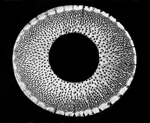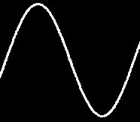
Wave - or particle?
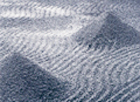
Detail of Zen sand garden
at Daisen-in, Daitoku-ji, Kyōto
'Standing waves' ...
Early 16th century
Photo: T.O.

The "Eastern Drop-collector"
Dry Zen garden at Ryūgen-in
Zen temple, Daitoku-ji, Kyōto
Established in 1504
Photo: T.O.
|
Chronology
THE WEST • 1298- ... including Europe, Scandinavia & Denmark in particular
1298: Marco Polo (1254-1324) mentions Japan ("Zipangu") in his memoirs - the first known reference by a Westerner to the "Land of the Rising Sun".
Read more here, link
1528: The oldest known map of Japan is produced in Venice, Italy.

The earliest known map of Japan, published by Niccolo Zoppino in Venice.
Read more here, link
1543: Three Portuguese traders drift ashore on the island Tanegashima south of Kyūshū, it is being reported and described.
1549: The Spanish Jesuit missionary Francis Xavier lands in Kagoshima and begins movement to spread Christian teaching in Japan.
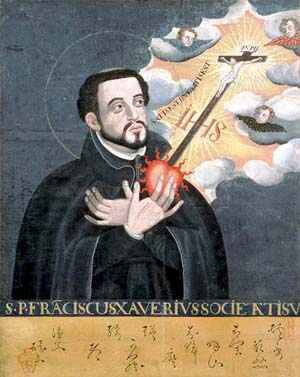
Japanese portrait of Francis Xavier (1506-1552)
Kōbe City Museum, Kōbe, Japan
1563 to c. 1570? - Luís Fróis, 1532 to July 8, 1597, was a Portuguese missionary.
He was born in Lisbon and in 1548 joined the Society of Jesus (Jesuits). In 1563, he arrived in Japan to engage in missionary work, and in the following year arrived in Kyoto, meeting Ashikaga Yoshiteru who was then Shogun.
In 1569, he befriended Oda Nobunaga and stayed in his personal residence in Gifu while writing books for a short while. His works on history were somewhat expanded by Joāo Rodrigues.
1577:
The number of Christened Japanese allegedly exceeds 100.000.
1581: The Jesuit Alessandro Valignano, 1539-1606, arrives in Japan.
1582-1585: A delegation of four Japanese Christian boys are sent to meet the Pope Gregor the 13th in Rome.
1584 - Italian Jesuit missionary Alessandro Valignano, S.J. writes in his report,
"They have rites and ceremonies so different from those of all other nations that it seems that they deliberately try to be unlike any other people.
The things they do in this respect are beyond imagining and it may truly be said that Japan is a world the reverse of Europe."
In: Cooper, 1965, the page before the Preface.
1585 - Luis Frois:
The First European Description of Japan, 1585: A Critical English-Language Edition
of Striking Contrasts in the Customs of Europe and Japan by Luis Frois, S.J.,
edited by Daniel T. Reff, Richard K. Danford, Robin D. Gill.
First impression: Taylor & Francis Ltd., 2014.
Reprint edition, Routledge, 2015.
1587: A first edict is issued by the new ruler Toyotomi Hideyoshi to expell Christian missionaries from Japan.
Hideypshi puts Nagasaki under his direct control.
1596; A 700 tons big richly loaded Spanish commerce ship, the San Filipe, with Franciscan missionaries on board, wrecks on the coast of the Tosa Province.
Toyotomi Hideyoshi suspects that this may be an attempt to invade Japan. The incident leads directly to the executions in Nagasaki the year after, in 1597.
Hideyoshi orders "The Great Sword Hunt" accotrding to which all warriors in the country should give up and hand over their swords.
1597:

"The Twenty-six Martyrs of Japan"
Painting by unnamed Japanese artist, probably early 17th century
On February 5, 1597, 26 Christians - missionaries and Japanese followers alike -
were crucified at Nishizaka in Nagasaki,
on the order of Toyotomi Hideyoshi, then the absolute ruler of Japan.
1605: Estimates indicate that at this time there are about 750.000 Christian converts in Japan.
1613: The shōgun, Tokugawa Ieyasu, issues a ban against Christianity in Japan, first for Edo, Kyōto, Ōsaka and Nagasaki..
1614: General persecution of Christians begins; expulsion of Spaniards.
1616: The Danish East India Company is formed under the reign of the mighty and famous King Christian IV.
One of company's goals is to reach Japan by ship and initiate trade.
1619: The first Danish attempt to reach Japan.
"Martin Spangberg becomes the first recorded Danish person to visit Japan. Spangberg is a part of Vitus Bering’s expeditions to explore the Far East and lands in Sendai Bay."
First Danish Attempt At Negotiating Trade Relations In Japan
Source - read more here, online: http://www.denmarkjapan150.jp/en/history/
1622 (1623?), September 10: The "Great Martyrdom" at Nagasaki. 132 arrested Christians die from torture, exhaustion or execution.
1626-1633: The Nagasaki city magistrate Mizuno Kawachi-no-kami and his successor Terazawa Hirotake organize a "reign of terror" against Christian converts,
most of them peasants, in the districts under their control.
1629: The practice of fumi-e - forced trampling of Christian images - is introduced.
The religious authorities of the Tokugawa shōgunate requires suspected Christians to step on images of Jesus Christ or the Virgin Mary
in order to prove that they are not members of that outlawed religion.
1634: The very small artifical island of Dejima in Nagasaki Bay on SW Kyūshū is first constructed to house Portuguese traders. With the total exclusion of foreigners,
not least all Christian Catholics, from Japan, from 1641 only the Chinese and protestant Dutch, English and German tradesmen are allowed to land and to have commercial and scientific dealings with Japan.

Painting of Dejima Island dated 1820.
1637: Christian farmers, warriors, rōnin (masterless samurai) and others revolt against the authorities on the Shimabara Peninsula in Kyūshū.
When the uprising is put down in 1638, tens of thousands are reported killed. All surviving rebels, numbering in the thousands, are executed by decapitation.
Christianity is now strictly outlawed in Japan and informers are encouraged.
1639, July 5: The captain-major of two visiting Portuguese ships at Nagasaki is presented with a copy of a decree
which orders the immediate and permanent cessation of all trade between the Portuguese and Japan.
1640, July: A portuguese vessel carrying a specially selected embassy reaches Nagasaki in one last attempt to persuade the shōgun to change his mind.
On August 1, the entire party is arrested and imprisoned.
1640, August 4: 61 of the prisoners are executed on "Martyr's Mount" - 13 native crew members are spared and sent back to the Portuguese colony Macao,
to report what has happened.
Source: C.R. Boxer, 1993, pp. 384-385.
1640: In direct consequence of the Shimabara Rebellion, the Tokugawa Bakufu orders the socalled Shūmon aratame-yaku,
or "Officers for Examining the Religious Sects", to be set up.
From this time on, the major sects of Buddhism were made responsible for producing registers of religious affiliation of every Japanese household with one specific Buddhist temple.
The socalled danka seido, or "Danka System", in which Japanese households since the Heian Period, 794-1185, has voluntarily been supporting the temples financially,
is now being reshaped into a most effective instrument with which the government can monitor the population and - first of all - suppress and eliminate the Christian faith and its believers,
on a mandatory basis.
As for the so called Fuke-shū, however, even though the komusō fraternity, though only allegedly!!!, is officially recognized by the Tokugawa government in January, 1678,
in some however doubtful capacity as a "religious brotherhood", the Fuke temples shall never play any role in administering the Danka System of the Edo Period.
Furthermore, the komusō are not known to have performed formal funeral and ancestor commemoration services,
nor do the Fuke temples appear to have had any cemeteries for the common population - nor themselves! - within their "temple" precincts.*
This possibly explains, at least in part, why it did not require much more than a few brush strokes for the Meiji Government - in October, 1871 -
to completely bring an end to the "Fuke Sect" and all komusō activity in Japan.
1642: The former warrior, loyal supporter of Tokugawa Ieyasu, and devoted Zen buddhist monk and writer Suzuki Shōsan, 1579-1655, completes his strongly anti-Christian essay
Ha Kirishitan, "Crush Christianity".
Interestingly, Suzuki Shōsan was an outspoken admirer of Fuke Zenji.
1651: A 'rōnin' revolt led by Yūi Shōsetsu is put down by the shōgunate.
1657-1658: An attempted revolt involving both 'rōnin' and Christians is discovered and the rioters eliminated.
1664: The shōgunate, or bakufu, orders every daimyō to establish in their domain an officer of religious investigation, i.e.
either a magistrate of religion (shūmon bugyō) or magistrate of temples and shrines (jisha bugyō).
1665: Registries of religious affiliation are now being produced on a nationwide scale. The primary purpose is to search for any possible Japanese Christian converts still hiding in every town and village,
hunt them down, persecute and execute them.
1671: The registry's format is finally standardized - the system of religious inspection and obligatory temple certification
has now become completely consolidated by law and is carried out effectively, on a yearly basis, in all of Japan.
1691: The German naturalist, physician, and explorer writer Engelbert Kaempfer (1651-1716) was allowed by by the authorities to travel in Japan twice outside of Dejima for limited periods of time.
Visiting Kyōto, among his many sketches, Kaempfer also made a drawing of the Great Buddha Hall of the Hōkō Temple, Higashiyama Area, SE Kyōto,
in the neighbourhood of which, acc. to tradition, the Kyōto Myōan Temple was also then located.
In his reports from this extraordinary journey, Kaempfer, however, did not make any reference to that particular temple.

Kaempfer's drawing of the Great Buddha Hall at the Hōkō-ji in SE Kyōto.

Map of old Kyōto: Location of the Great Buddha Hall of the Hōkō-ji
1739, June 16: "Martin Spangberg becomes the first recorded Danish person to visit Japan.
Spangberg is a part of Vitus Bering’s expeditions to explore the Far East and lands in Sendai Bay."
Read more here: http://www.denmarkjapan150.jp/en/timeline/first-dane-to-reach-japan/
1775-76: The Swedish naturalist Carl Peter Thunberg, also known as Karl Peter von Thunberg, Carl Pehr Thunberg, or Carl Per Thunberg (November 11, 1743 – August 8, 1828) visits and studies in Japan.
Early 1800s: The first bamboo plants are imported in Europe from China, sometime later from Japan, also.
"In the 21st century, we are witnessing an enormous increase in 'bambooism'.
At present over 400 different taxa are cultivated in Europe, over 300 of which are temperate bamboos."
Link to the source: http://eng.bambooselect.com/bambooineurope.html.
1832:
The German physician, botanist, and traveler Philipp Franz Balthasar von Siebold (1796-1866) lives, works and researches in Japan, 1823-1829 - under false "Dutch" identity - based on Dejima at Nagasaki in Southern Japan.
After his return to Europe, in 1832, he publishes his first illustrated report on Japan, "Nippon", in which publication you also find this charming drawing of a mendicant fluteplaying komusō:

Komusō with an assistant in Siebold's "Nippon", 1832
Philipp Franz Balthasar von Siebold: Nippon. Archiv Zur Beschreibung
Von Japan Und Dessen Neben- Und Schutzländern.
Jezo Mit Den Südlichen Kurilen, Krafto, Kooraï Und Den Liukiu-Inseln,
nach japanischen und europäischen Schriften und eigenen Beobachtungen.
Leyden: bei dem Verf.; Amsterdam: Muller; Leyden: Hoek; Leyden: Lau, 1832-
Link: http://digital.bibliothek.uni-halle.de/hd/content/titleinfo/977570
1846, August 18-:

The Danish corvette Galathea off Cape Town in South Africa.
Painting by C. W. Eckersberg, 1783-1853. The Royal Danish Naval Museum's archive.
The First Danish attempt at negotiating trade relations in Japan fail.
Rear Admiral Steen Andersen Bille, 1797–1883, travelling round the world on board his famous corvette "Galathea" reaches the shores of Japan but is denied entry to the country by the Japanese authoririties.
"Based on his travels, Bille is the first Dane to write about Japan in Danish. His books are published in 1849-51 and are very influential on future Danish accounts about Japan."
Source - read more online here: http://www.denmarkjapan150.jp/en/history/

Japanese writing set forgotten and left behind on the Galathea by an official Japanese clerk in 1846.
Now in the collection of the Dept. of Ethnography, National Museum of Denmark, Copenhagen.
Photo: John Lee.
Source: Joan Hornby article in Borggren, Hornby, Ejersbo-Iversen & Krarup Edl, editors, 2008

"En Japaneser fra Yeddo Bugten" ("A Japanese at Yeddo Bay")
Source: Steen A. Bille, Vol. 2, Copenhagen, 1850, facing page 412
1853 - THE ARRIVAL of COMMODORE PERRY in JAPAN
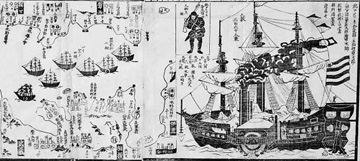
Admiral Perry's second fleet in Japan, 1854
Japanese print, 1854 - artist unknown
July 8, 1853: US admiral Matthew Calbraith Perry, 1794-1858, arrives with a small fleet in the Tōkyō Bay commissioned to negotiate a US trade treaty with Japan.
Perry threatens the city of Uraga with the ships' powerful guns and the Japanese authorities (the shōgunate) agree to receive a letter of request from US President Millard Fillmore.
Returning with twice as many ships in February, 1854, on March 31, Perry finally succeeds in having signed a friendship treaty between The United States of America and Japan.
1853-1854:
Eliphalet Brown, Jr., 1816-1886, Admiral Commodore Perry's
official photographer, is the very first to take pictures of Japan
and its people, using the daguerreotype photo technnique.
Since then, the art of photography soon becomes widespread throughout the country.
Link to more about photograpgy in Japan: http://www.baxleystamps.com/litho/brown.shtml
1853, June:

Eliphalet M. Brown Jr. shooting daguerreotypes in Okinawa
- the first photographs taken on "Japanese" soil, June 1853
Source - read more via this link: https://www.flickr.com/photos/24443965@N08/2363597408/?ytcheck=1
1854:

Commodore Perry's Second Japan Fleet
Source - read more via this link: https://en.wikipedia.org/wiki/Sakoku
1854: Japan opens for free foreign, international trade.
1856:
French amateur botanist Eug`ne Mazel, 1828-1890, establishes The Bambouseraie de Prafrance, today a private botanical garden specializing in bamboos,
located in Générargues, near Anduze, Gard, Languedoc-Roussillon, France. The garden contains one of Europe's oldest bamboo collections.
Links to sources: https://en.wikipedia.org/wiki/Bambouseraie_de_Prafrance
& https://fr.wikipedia.org/wiki/Bambouseraie_de_Prafrance & http://www.bambouseraie.com/en.
1860s ... :
From the 1860s, ukiyo-e, Japanese wood-block prints are imported in considerable numbers to Europe and become a source of inspiration
for many European impressionist painters in France and elsewhere.
Source: Wikipedia,
1861/1864:

"Japanischer Bettler als Klarinettbläser"
"A Japanese Beggar as Clarinet Player"
Komusō in Gustav A. Spieß, 1864, page 201
This is but the second oldest known Western picture of a performing shakuhachi-playing beggar lay monk. It was printed from an engraving based on an original photograph taken in 1861 somewhere in Nagasaki in SW Japan by either August Sachtler or John Wilson during the visit there of the official Prussian Expedition to Japan, 1860-61.
1867, January 12: Denmark and Japan sign the mutual Treaty Of Friendship, Commerce And Navigation.
1872:
French art critic Philippe Burty, 1830–1890, introduces and defines the new art concept and term "Japonisme".
Source: Wikipedia.
1878 - Alessandro Kraus:
La Musique au Japon. Impr. de "L'Arte della stampa, 1878.
1886: Japonism is introduced in Denmark by painter and art historian Karl Madsen who writes the book “Japansk Malerkunst” ("The Art of Japanese Painting").
1888: World famous author H.C. Andersen's "The Emperor’s New Clothes" is the first of his fairytales to be translated - or, rather: adapted to - the Japanese language.
1888:
In the Summer of 1888, world famous Dutch post-impressionist painter Vincent van Gogh writes in two letters to his brother Theo,
"About staying in the south, even if it’s more expensive — Look, we love Japanese painting, we’ve experienced its influence—all the Impressionists have that in common —
[so why not go to Japan], in other words, to what is the equivalent of Japan, the south? So I believe that the future of the new art still lies in the south after all."
(Letter 620)
"All my work is based to some extent on Japanese art ..."
(Letter 640)
Van Gogh's collection of numerous Japanese ukiyo-e is now housed and exhibited in the fascinating Van Gogh Museum in Amsterdam.
Link to source: https://en.wikipedia.org/wiki/Japonaiserie_(Van_Gogh)
1891 - James Legge:
The Texts of Taoism.
Reprinted from Sacred Books of the East, vols. 39 and 40,
Oxford, 1891. Julian Press, New York, 1961.
1893, 1909, 1969, 1971 - Francis Taylor Piggott, 1852-1925:
Japanese Music and Musical Instruments
Second edition: Shanghai, Hongkong, Singapore & London, 1909.

Francis T. Piggott describes the shakuhachi on page 152 in his pioneering 1893 book.
Direct link to the page in question
1899:
Edmond Papinot & Terence Barrow: Historical and geographical dictionary of Japan,
with an introduction to the new ed. by Terence Barrow.
Tuttle Publishing, Rutland, Vermont, 1989.
First edition in English translation by Terence Barrow publ. in 1910.
Edmond Papinot: Dictionnaire japonais-francais des noms principaux de
l'histoire et de la géographie du Japon suivi de
17 appendices sur les empereurs, shōgun, nengō,
sectes bouddhistes, provinces, départements, mesures, etc.
Hongkong, 1899.
According to Edmond Papinot, writing in 1899 in French, here translated to English:
"Fuke-shū, 普化宗.
A branch of the Zen sect, founded by the Chinese bonze Fuke-Zenji.
In 1248, the bonze Kakushin went to China, where the famous Busshō-Zenji of the Gokoku-ji temple taught him the doctrines of the sect.
There was a certain Chōyū in the temple who was very skilful in playing the flute (shakuhachi) and from him Kakushin received lessons.
After his return to Japan (1254), he went through the country preaching and playing the flute.
His successors Kichiku and Komu did likewise, and the name of the latter, Komu-sō has become the generic name by which
travelling bonzes of the sect were designated.
Under the Tokugawa, many samurai without masters enrolled in the Fuke-shū sect, dressed in the traditional costume and wore large hats
so as to hide their faces.
They went through the country begging and playing the flute.
To avoid justice or the supervision of the shogunate, it became customary to become a Komusō;
but disorders having ensued, Ieyasu published a regulation to fix their privileges and their obligations.
The sect has seventy-three temples, all depending on Ichigetsu-ji at Koganei (Shimōsa).
It was interdicted at the Restoration."
1901-1905: Johanne Münter is the first female Danish writer to convey both Japan and Japanese culture to a Danish audience.
1903:

Oil painting by Sakaki Teitoku, 1858-1939: "Concert by Japanese and Western Instruments"
Nagasaki Prefectural Art Museum, Japan
1903:


Wilhelm Rasmussen: Japan.
Frem/Det Nordiske Forlag, Ernst Bojesen, Copenhagen, 1903.
This is one among the first comprehensive Danish books about Japan written for the general public and published in Denmark around the turn of the 19th to 20th centuries.
1921, March 1: The first Danish embassy is established in Japan.
1928:

The composers Edgar Varese and Henry Cowell
1930, March: The Japan-Denmark Society is formed in Japan.
1932 - Alan W. Watts:
An Outline of Zen Buddhism.
32 page pamphlet, The Golden Vista Presa, 1932.
Early 1930s:

Explains Dean Delbene,
"Early 1930's New York; Henry Cowell with shakuhachi, and participants in his course "Music of the World's Peoples"
at New School for Social Research.
The man in the lower right may be Cowell's shakuhachi Sensei.
One of Cowell's most famous courses at the New School was "Music of the World's Peoples" which, in combination with concerts of non-Western music,
became a model for the propagation of world culture.
Believing since childhood that all music was equally valid, he had studied Japanese and Bengali instruments and theory in New York,
and in 1931, armed with a Guggenheim Fellowship, eagerly devoured the gigantic recorded collection of non-Western music at the University of Berlin.
Cowell became convinced that composers should be able to regard the world's music as a pool of resources from which they could draw anything from any culture that stimulated them.
For the rest of his life he passionately informed anyone who would listen about the glories of our planet's musics."
Source: http://myoanshakuhachi.blogspot.dk/2010_04_01_archive.html
1936 - Alan W. Watts:
The Spirit of Zen.
A Way of Life, Work and Art in the Far East.
E.P. Dutton, 1936.
1943:
Jūdō, the Japanese art of weaponless self-defense, is first introduced in the training of the Danish freedom fighters during the German occupation
in World War 2, 1940-1945.
1948 - Fung Yu-lan:
A Short History of Chinese Philosophy.
The Free Press, New York & Collier-MacMillan Limited,
London, 1948, 1968.
1948, May 1:
Dansk Jūdō Union i established in Denmark.
1948 - Eugen Herrigel:
Zen in der Kunst des Bogenschiessens.
Weller, Konstanz, 1948; Barth, München-Planegg, 1951.
Published in English in 1953. Published in Japanese in 1955.
See also: 2001 - Yamada Shōji, a qualified comment regarding "Zen and Archery".
1950-1953 - Daisetzu Teitarō Suzuki:
Essays in Zen Buddhism I, II & III.
Rider & Company, London, Vol. I: 1950, 1980. Vol. II: 1953, 1980.
Vol. III: 1953, 1977.
1951, September 10:
Japanese film creator Kurosawa Akira's movie Rashōmon surprisingly wins the Golden Lion prize at the Venice Film Festival.
The big cultural and commercial succes of that film, in both Europe and USA, is soon repeated by the following Kurosawa movies such as
Seven Samurai, 1954, and Yojimbo, 1961.
Link to source: https://en.wikipedia.org/wiki/Akira_Kurosawa
1951 - C.R. Boxer:
The Christian Century in Japan, 1549-1650.
Carcarnet Press Limited, Manchester, 1993.
First published in 1951 by The University of
California Press & the Cambridge University Press.
1951 - Vern Sneider:
The Teahouse of the August Moon.
G. P. Putnam's Sons, New York, 1951.
An American novel based on US Army government officers and personnel
activities and experiences during their occupation of Okinawa in post-WW2 Japan.
1952 - Paul Yachita Tsuchihashi:
Japanese Chronological Tables
from 601 to 1872 A.D.
Sophia University Press, Tokyo, 1952.
1953 - Eugen Herrigel:
Zen in the Art of Archery.
United States, 1953.
Originally published in German in 1948.
1953 - Schuyler van R. Cammann:
'Types of Symbols in Chinese Art.'
In: The American Anthropologist, 'Studies in Chinese Thought',
Vol. 55, No. 55, Part 2, 1953.
1954 - Hubert S.J. Cieslik:
'The Great Martyrdom in Edo, 1623.'
In: Monumenta Nipponica X, 1954, pp. 1-44.
Link to online PDF file:
http://pweb.cc.sophia.ac.jp/britto/xavier/cieslik/cie_greatmartyrdom.pdf
1956 - Machida Kashō:
'Japanese Music and Drama in the Meiji Period.'
In Vol. III of Japanese Culture in the Meiji Era, compiled and
edited by Komiya Toyotaka, translated and adapted by
Donald Keene & Edward G. Seidensticker.
Ōbunsha, Tōkyō, 1956, pp. 370-377.
1956: Vern Sneider's novel "The Teahouse of the August Moon" is filmed and published as a movie,
starring Marlon Brando.
1957 - Alan W. Watts:
The Way of Zen.
Pantheon Books, 1957, 1971.
1957 - George M. Beckman:
The Making of the Meiji Restoration.
The Oligarchs and the Constitutional Development of Japan, 1868-1891.
University of Kansas Press, Lawrence, 1957.
1958 - Hori Ichirō:
'On the Concept of Hijiri (Holy Man).'
In: Numen 5, 2 (April), pp. 128-160; Numen 5, 3 (September), pp. 199-232, 1958.
1958-1964 - George Sansom:
A History of Japan.
The Cresset Historical Series, London, 1958-1964.
1958: The Denmark-Japan Society is formed.
1958, April 1: The first Japanese Embassy is established in Denmark,
1959 - Alan W. Watts:
Beat Zen Square Zen and Zen.
City Lights Books, San Francisco, 1959.
1959 - William P. Malm:
Japanese Music and Musical Instruments.
1st edition. Tokyo, New York & London, 1959.
1960s?

The US American jazz musician John Coltrane
Name of photographer, date and place of photo is so far unclear
1960 - Edwin O. Reischaur & John K. Fairbank:
East Asia. The Great Tradition. A History of East Asian Civilization, Vol. 1.
Houghton Mifflin Co., Boston, Mass., 1960.
1960 - R.H. Blyth:
Zen and Zen Classics, Vol. 1: General Introduction.
From the Upanishads to Huineng. The Hokuseido Press, Tokyo, 1960.
1962 - Joseph Needham:
Science and Civilisation in China, Vol. 4.
Physics and Physical Technology: Sound (Acoustics).
Cambridge At the University Press, Cambridge, 1962.
1963 - Heinrich Dumoulin:
A History of Zen Buddhism.
Pantheon Books, New York, 1963.
1964: The Tokyo Olympic are held in Japan and broadcasted to many countries in the young, new world of television.
1964/1998:

Kokū Nishimura: Kyotaku CD
Recorded on Kyūshū in 1964. Remastered, produced and released
worldwide by Anders Nordin, Denmark/Sweden, in 1998.
Link til Discogs.com
1965:

Tony Scott: Music for Zen Meditation and Other Joys
Also starring: Yamamoto Hozan, shakuhachi (Tozan-ryū), and Yuize Shin'ichi, koto/sankyoku.
Link til Discogs.com
As you may already be aware of, the music on this album has absolutely nothing to do with "Zen music", at all.
1965:
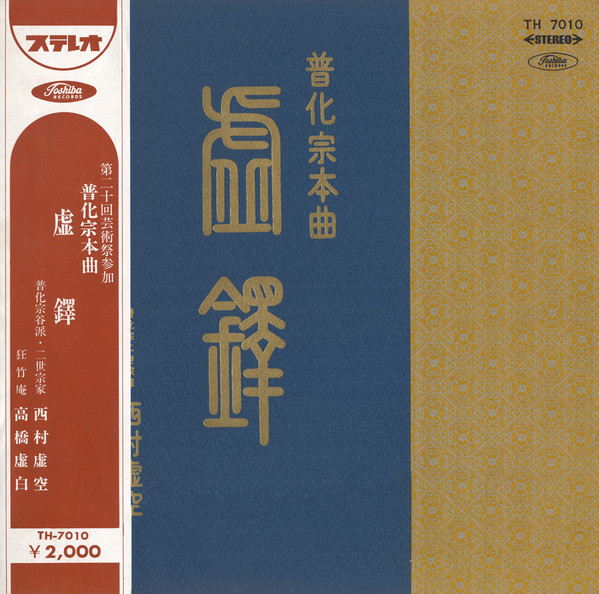
Nishimura Kokū: 'Kyotaku' LP, 1965
Toshiba Records TH-7010, first impression
Link to Discogs.com
1965 - Michael Cooper, S.J., editor:
They Came to Japan. An Anthology of European Reports on Japan, 1543-1640.
University of California Press, Berkeley, Los Angeles, 1965.
1966: Kishibe Shigeo:
The Traditional Music of Japan.
Kokusai Bunko Shinkokai, Tokyo, 1966.
1967:

Masterpieces for the Shakuhachi
Masters of Meian-ryū, Kimpu-ryū, Tozan-ryū and Kikusui-ryū
Link til Discogs.com
On this most memorable vinyl LP record you hear the earliest ever
Kyōto Myōan Taizan-ha honkyoku presented to a Western audience, namely:
Kokū, 虚空,
performed by two shakuhachi players at the Myōan Temple in SE Kyōto
probably sometime in the mid-1960s.
1967: The 5th James Bond movie "You Only Live Twice" is premiered, primarily filmed in Japan and featuring both American and Japanese actors.
1967, November: Takemitsu Tōru's celebrated modern music composition "November Steps" premiers in New York.

Tsuruta Kinshi (biwa) and Yokoyama Katsuya (shakuhachi) perform "November Steps"
with the New York Philharmonic Orchestra conducted by Ozawa Seiji, November 1967.
Source of photo collage: https://en.wikipedia.org/wiki/November_Steps
Read more at: https://en.wikipedia.org/wiki/November_Steps.
1967-1968:
Yamaguchi Gorō is appointed and teaches shakuhachi as "Artist in Residence" at Wesleyan University in Middletown, Connecticut, USA.
In 1968, Yamaguchi records the two soundtracks for the music LP album "A Bell Ringing in the Empty Sky",
that was released internationally on the Nonesuch Records label in that same year, see below.
1967 - F.A. McClure:
The Bamboos. A Fresh Perspective.
Harvard University Press, Cambridge (Massachusetts), 1967.
1968 - Elliot Weisgarber: "The Honkyoku of the Kinko-ryū:
Some Principles of its Organization."
In: Ethnomusicology XII, 3 (September), 1968, pp. 313-344.
1968: The Eastasian Instute at the University of Copenhagen begins to offer Japanese language courses to interested students.
1968, September: Torsten Olafsson enrolls in the Chinese Arts & Culture academic study program at the Eastasian Insitute, Copenhagen.
1969 - Charles E. Tart, editor:
Altered States of Awareness. A Book of Readings.
John Wiley & Sons, Inc., New York, London, Sidney, Toronto, 1969.
1969 - Donald Paul Berger:
'The Shakuhachi and the Kinko Ryū Notation.'
In: Asian Music, Vol. 1, No. 2, Autumn, pp. 32-72.
Texas University Press, 1969.
1969:

Gorō Yamaguchi – A Bell Ringing in the Empty Sky
Cover notes in English by Koizumi Fumio.
Link til Discogs.com
1970s?

The US American jazz musician James Moody
Name of photographer, date and place of photo is so far unclear
1970-1971: Araki Kodō V of the Edo Kinko Shakuhachi School is teaching as "Visiting Artist" at the Wesleyan University in Middletown, Connecticut, USA.
A prominent shakuhachi student of his is Andreas Gutzwiller from Switzerland.
1970:
Monty H. Levenson, USA, sets up his Japanese bamboo flute brand "Tai Hei Shakuhachi" workshop - and, eventually: his Shakuhachi Music Publishing Company -
in Willits, in the mysterious Red Woods district of Northern California, as also in Tokushima on the island of Shikoku in Japan.



As of now,
Monty H. Levenson makes shakuhachi (Tai Hei Shakuhachi) and maintains workshops at his home in the hills of Mendocino County, California,
as well as in Japan in the small farming village of Kitagawa in Tokushima Prefecture on Shikoku Island.
Later, in 1984, Monty developed the precision cast bore technology which enabled him to create affordable, high-quality shakuhachi made of bamboo.
Tai Hei Shakuhachi are now being used by traditional teachers in Japan for their students and professional musicians worldwide as their personal instruments.
Monty Levenson has collaborated extensively with many prominent players and craftsmen in Japan.
2001 saw the development of the Shakulute, a completely new concept in woodwinds instruments.
It replaces the side-blown headjoint of the western transverse flute with that of an end-blown shakuhachi head joint to create an innovative new sound and style of music.
This hybrid instrument allows the player to employ blowing styles and techniques distinctive to the traditional Japanese shakuhachi while using fingerings common to the western classical Boehm flute.
The resulting sound is a unique blend of East and West that can be achieved on no other instrument.
The Shakulute has gained enormous popularity amongst flute players around the world since its inception. Gatherings of Shakulute players have convened annually in Japan since 1999.
In 2004, Tai Hei Shakuhachi Publishing was officially launched with the aim of preserving and expanding access to information outside of Japan on shakuhachi craft work and the honkyoku tradition.
Several playing guides, flute craft manuals, books on the origins and history of shakuhachi, as well as traditional and contemporary sheet music, CDs and DVDs have been published under the Tai Hei Shakuhachi imprint.
Direct link to www.shakuhachi.com
1970 - Daisetzu Teitarō Suzuki:
Zen and Japanese Culture.
Princeton University Press, Princeton, 1970, 1973.
1971: The University of Copenhagen now offers academic degrees not only in Chínese Studies, but in Japanese Studies as well.
1971 - Hōseki Hisamatsu Shin'ichi:
Zen and the Fine Arts.
Kodansha International Ltd.,
Tokyo, New York & San Fransisco, 1971.
1971:

Watazumidō-Shūso – The Mysterious Sounds of the Japanese Bamboo Flute
Link til Discogs.com
Early 1970s - Monty H. Levenson:
The Japanese Shakuhachi Flute. Notes on the Craft & Construction.
Willits, California, USA, early 1970s.
1971 - Ralph Samuelson:
Some Aspects of the Kinko-ryū Honkyoku.
Unpublished MA thesis, Wesleyan University, Middletown (Connecticut), 1971.
1971-1972: Kawase Kansuke of the Edo Kinko Shakuhachi School takes over the shakuhachi program as new Japanese "Visiting Artist" at the Wesleyan University.
Andreas Gutzwiller continues his shakuhachi studies with Kawase Kansuke as his new teacher.
1972:
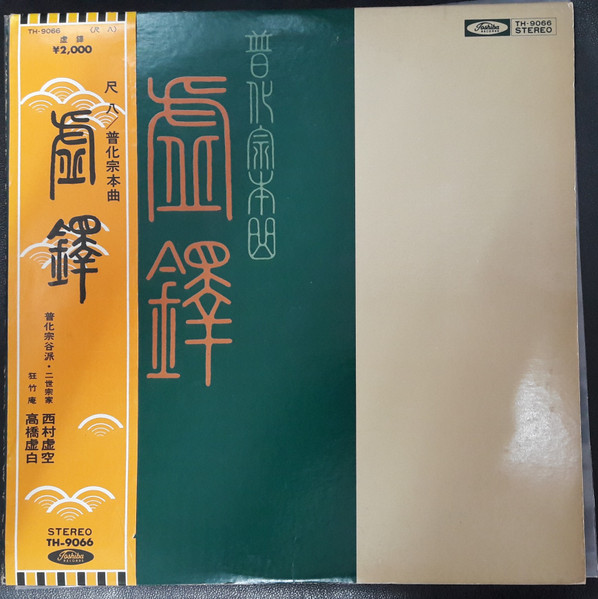
Nishimura Kokū: 'Kyotaku' LP
Toshiba Records TH-9066, second impression
Link to Discogs.com
1972 - Timothy Teyler:
Altered States of Awareness.
Readings from Scientific American Paperback, June, 1972
1972-1976 - Nancy Beckman, USA, studies Myōan Taizan-ha shakuhachi honkyoku in Kyōto.
Fukumoto Kyōan and Yoshimura Fuan Sōshin, the 39th and 40th heads of that shakuhachi tradition, are her teachers.
Nancy Beckman receives the name Fukushin and her Taizan-ha teacher's license menkyō kaiden from the Myōan-ji in 1976,
as the first - and still only - Western female player in that very capacity.
1974 - The first ever shakuhachi concert event in Copenhagen, Denmark:
Yokoyama Katsuya performs solo and in duet with his father Yokoyama Ranpo.
Venue: Kunstindustrimuseet in Copenhagen, the capital, now known as Design Museum Denmark.
1974, October: Torsten Olafsson enrolls in the Japanology study program at the Eastasian Institute, Copenhagen.
There he studies classical Japanese literature with present professor emerita Kirsten Refsing (Hong Kong/Copenhagen),
classical Japanese poetry with present professor emerita Esperanza Ramirez-Christensen (Harvard/Univ. of Michigan),
and the late professor Olof Lidin (Stockholm/Berkley/Copenhagen/Berlin) as his principal teachers.
1974:

Sakai Chikuhō II: Suizen. Chikuhō ryū ni miru fuke shakuhachi no keifu.
Columbia LP: KX-7002, Japan, 1974.
This album (so far not reissued digitally) also features an article in Japanese
by the musicologist Kamisangō Yūkō.
That article should prove to become quite influential in the West,
in a negative sense, in USA especially,
since Christopher Yohmei Blasdel, 12 years later, included his translation - or, rather:
his own "adaptation" - in English in the book of his, "The Shakuhachi.
A Manual for Learning", first published in Japan in 1986 and reissued in 2008.
Link to 'Suizen' at Komuso.com
Read about the deplorable falsifying effect on shakuhachi history writing caused by the Kamisangō/Blasdel 1974/1986 accounts here:
1974 ...: Untruthful 'Suizen' & "Shakuhachi Meditation"
Information & Assertions, East & West
- Presented in Western Languages, Primarily
1974 - Hirai Tomio:
Psychophysiology of Zen
Igaku Shoin, Tokyo, 1974.
1974 - Daigan Matsunaga & Alicia Matsunaga:
Foundation of Japanese Buddhism. Vol. I:
The Aristocratic Age. Vol. II: The Mass Movement.
Buddhist Books International, Los Angeles, Tokyo, 1974, 1976.
1975 - Ruth Fuller Sasaki, translator:
The Record of Lin-Chi.
The Institute for Zen Studies, Kyōto, 1975.
1975 - Sekida Katsuki:
Zen Training. Methods and Philosophy.
John Weatherhill, Inc., New York, 1975.
1977:
Yamaguchi Gorō's shakuhachi music is launched into Outer Space.
Yamaguchi's 1968 recording of the Kinko-ryū honkyoku Sōkaku reibo,
巣鶴鈴慕,
"Cranes Nesting", in other shakuhachi schools known as Tsuru no sugomori,
鶴の巣籠り,
is chosen as one of many unique examples af music created, performed and appreciated on our planet, The Earth.


"The Voyager Golden Records are phonograph records that were included aboard both Voyager spacecraft launched in 1977.
They contain sounds and images selected to portray the diversity of life and culture on Earth,
and are intended for any intelligent extraterrestrial life form, or for future humans, who may find them."
Wikipedia source: https://en.wikipedia.org/wiki/Voyager_Golden_Record
1977 - James H. Sanford:
'Shakuhachi Zen. The Fukeshū and Komusō.'
In: Monumenta Nipponica XXXII, 4. Sophia University, Tokyo, 1977.
1977 - Tsuge Gen'ichi:
'The History of the Kyotaku.'
In: Asian Music, Vol. VIII, 2. New York, 1977.
Link to online at version:
http://links.jstor.org/sici?sici=0044-9202(1977)8%3A2%3C47%3ATHOTK%3E2.0.CO%3B2-M
1978 - Hirai Tomio:
Zen and the Mind. Scientific Approach to Zen Practice.
Japan Publications, Inc., Tokyo, 1978.
1979:

Kinshi Tsuruta et Katsuya Yokoyama: Japon - Musique Millénaire - Biwa et Shakuhachi
Link til Discogs.com
1979 - Ingrid Fritsch:
Die Solo-Honkyoku der Tozan-Schule: Musik für
Shakuhachi zwischen Tradition und Moderne Japans.
In: Studien zur traditionellen Musik Japans, Vol. 4,
Bärenreiter, Kassel, 1979.
1979 - Nakatsuka Chikuzen:
Kinko-ryū shakuhachi shikan.
Nihon Ongaku-sha, Tokyo, 1979.
This republication of Nakatsuka Chikuzen's monumental series
of monthly articles in the late 1930s Japanese music magazine Sankyoku
is included here because of its fundamental importance for the present
Zen Shakuhach Truth Research Web Page project.
1979 - Peter Judd Arnesen:
The Medieval Japanese Daimyo.
Yale University Press, New Haven and Londion, 1979
1980:
John Clavell's 1975 bbestselling novel Shō:gun" is filmatized into a TV mini-series starring Richard Chamberlain in the role as Anjin-san, the British Pilot-Major John Blackthorne,
who landed in Japan in the year 1600 and was imprisoned together with his crew. In real life the name of the navigator was the Englishman William Adams (1564-1620).
The series enjoyed considerable popularity when it was shown on Danish television.
1981 - Martin Collcutt:
Five Mountains. The Rinzai Zen Monastic Institution in Medieval Japan.
Harvard University Press, Cambridge (Massachusetts) and London, 1981.
1981 - George Elison & Bardwell L. Smith, editors:
Warlords, Artists, and Commoners.
Japan in the Sixteenth Century.
University Press of Hawaii, 1981.
1981 - James H. Sanford:
Zen-man Ikkyū.
Harvard University Center for the Study of World Religions, 1981.
1983:
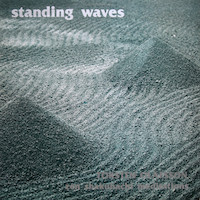
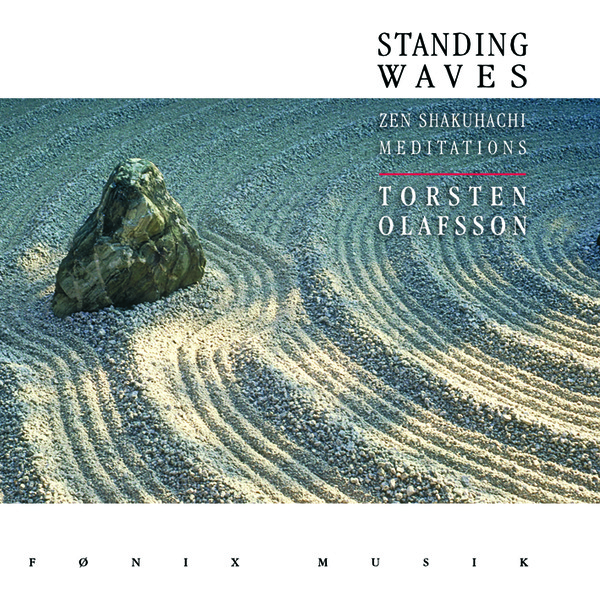
Torsten Olafsson: Standing Waves - Zen Shakuhachi Meditations.
This record is probably the first shakuhachi record to be produced and published in Europe.
Produced by Finn Olafsson. Engineered by Flemming Rasmussen at Sweet Silence Studios, Copenhagen.
The album was reissued internationally on the Fønix Musik label, Denmark, in 2001.
Link til Discogs.com (a)
Link til Discogs.com (b)
1983: The National Museum of Denmark, Dept. of Ethnography, features the grand summer exhibition "Japan i Brede" designed inside
of the former industrial complex buildings in the small village Brede north of Copenhagen.
Torsten Olafsson's LP/MC album "Standing Waves - Zen Shakuhachi Meditations" is released in cooperation with the museum.
The solo shakuhachi sound track is used as the background music continuously playing in the exhibition areas,
and Torsten gives a number of Myøan Taizan-ha shakuhachi lectures and mini concerts in the exhibition's Japanese garden.
1983: Torsten Olafsson is engaged by the National Museum as a Japanology trained photo documentation consultant. While researching and collecting proper and suitable pictorial material
for the "Japan i Brede" exhibition displays and montres, Torsten also discovers the below komusō woodcut print in one of the Japanese Edo Period travel guide books preserved
in the museum's impressive archive department.
With the permission of the museum, that historically important illustration shall later be presented in both the "Standing Waves" CD booklet, 2001, and on the front of the printed introduction edition
for Torsten Olafsson's Kaidō honsoku thesis, published by Tai Hei Shakuhachi, Californaia, in 2003.
Interestingly, a couple of years afterwards that unique komusō picture is printed in a Japanese shakuhachi history book for the very first time, namely in Yamaguchi, 2005, p. 178.

Woodcut print of a 'komusō' receiving alms
In: 'Yamato meisho zue', 大和名所図絵, "Pictures from Famous Places in Japan"
Illustration by Takehara Shinkei, 1791
The National Museum of Denmark, Department of Ethnography, Copenhagen
Photo reproduction by John Lee.
1983 - Joan Hornby, chief editor:
Japan - Brede, Nationalmuseets sommerudstilling i Brede 1983.
Exhibition catalog and Japan i Brede theme book with contributions from:
Joan Hornby, Kirsten Refsing, Erik Fæ Olesen a.o.
Nationalmuseet, Copenhagen, Denmark, 1983.
1983: The British Shakuhachi Society is established in England, probably in this year.
1983 - Andreas Gutzwiller:
Die Shakuhachi der Kinko-Schule.
In the series 'Studien zur traditionellen Musik Japans, Band 5.
Bärenreiter - Kassel, Basel, London, 1983.
1983 - Matsuda Tomihiro, ed., et al.:
A Dictionary of Buddhist Terms and Concepts.
Nichiren Shoshu International Center, Tokyo, 1983.
1984: The Danish National Museum's "Japan i Brede" exhibition is put on display at Moesgård Pre-historical Museum just south of Århus in ME Jutland.
During the opening festivities, Danish Torsten Olafsson plays Myōan Taizan-ha shakuhachi honkyoku in the presence of the then ambassador of Japan and other prominent guests.
Torsten also gives a shakuhachi lecture and a mini shakuhachi concert in the museum's lecture hall.
1985 - Herman Ooms:
Tokugawa Ideology. Early Constructs, 1570-1680.
Princeton University Press, Princeton, New Jersey, 1985.
1985 - Tonomura Hitomi:
'Forging the Past: Medieval Counterfeit Documents.'
Monumenta Nipponica 40, 1, 1985, pp. 69-96.
1986 - Christopher Blasdel & Kamisangō Yūkō:
The Shakuhachi. A Manual for Learning.
Printed Matter Press, Tokyo, 1986, 2008.
Available at www.shakuhachi.com.
1986 - Kirsten Refsing:
The Ainu Language: The Morphology and Syntax of the Shizunai Dialect.
Aarhus University Press, Aarhus, Denmark, 1986.
1987 - Torsten Olafsson:
Kaidō Honsoku, 1628: The Komosō's Fuke Shakuhachi Credo.
On Early 17th Century Ascetic Shakuhachi Ideology.
Published by Tai Hei Shakuhachi, California, 2003.
Includes a CD-ROM with the author's complete M.A. thesis on the same subject.
Eastasian Institute, University of Copenhagen, Denmark, 1987.
Available from: www.shakuhachi.com
1988 - Yamasaki Taikō:
Shingon. Japanese Esoteric Buddhism.
Shambala, Boston & London, 1988.
1990:
Tim Pallis, then a librarian at the Royal Library in Copenhagen, publishes his first book on Zen: "Zen, træning og tradition".
1990 - Takahashi Tone:
Tozan-ryū: An Innovation of the Shakuhachi Tradition from Fuke-shū
to Secularism. Unpublished Doctor of Philosophy thesis.
The Florida State University, 1990.
Available from: www.shakuhachi.com
1990 - Dan E. Mayers, author & editor:
Annals of the International Shakuhachi Society. Vol. 1.
Sussex, England: The International Shakuhachi Society, 1990.
Link to to society's website: http://www.komuso.com.
1991 - Gregg W. Howard:
'Musico-religious implications of some Buddhist views
of sound and music in the Sūrangama Sūtra.'
In: Musica Asiatica Vol. 6, Cambridge University Press,
Cambridge, England, 1991, pp. 95-101.
1993 - Riley Kelly Lee:
Yearning for the Bell: A Study of Transmission
in the Shakuhachi Honkyoku Tradition.
PhD thesis, University of Sidney, 1993.
Available online at: www.rileylee.net/thesis.html.
1994 - Tsukitani Tsuneko, Seyama Tōru & Simura Satoshi:
'The Shakuhachi: The Instrument and its Music,
Change and Diversification.'
In: 'Contemporary Music Review', 1994, Vol. 8, Issue 2,
pp. 103-129. Translated by Riley Kelly Lee.
Link to free download: www.informaworld.com
1996 - Kirsten Refsing:
Early European Writings on the Ainu Language.
Routledge, London, 1996.
1998 (1964):

Kokū Nishimura: Kyotaku CD
Recorded on Kyūshū in 1964. Remastered, produced and released
worldwide by Anders Nordin, Denmark/Sweden.
Link til Discogs.com
1998 - James H. Austín:
Zen and the Brain:
Toward an Understanding of Meditation and Consciousness.
MIT Press, Cambridge, Massachusetts, 1998.
1998:

The first World Shakuhachi Festival takes place in Boulder, Colorado, USA:
Aoki Reibo, Yamamoto Hozan, David Wheeler, Yamaguchi Gorō,
Yokoyama Katsuya & Araki Kodō V
1999, early Autumn: The late Dan E. Mayers, Esq., then President of the International Shakuhachi Society, England, invites Torsten Olafsson to meet with him
while he is participating in an international chess competition taking place in Copenhagen, Denmark.
While enjoying a very nice dinner together in a fashionable fish restaurant very close to the Danish Parliament: Christiansborg, Dan kindly (but quite insistingly)
invites Torsten to compose a short introduction to his 1987 university thesis about the 'Kaidō honsoku' document, dated 1628.
Only a few years later, Torsten's essay is published, first by Monty H. Levenson, in 2003 - then again in the ISS Annals Vol. 2, 2005.
1999, late Autumn: Anders Nordin acts as competent host in Copenhagen, Denmark, of the renowned late Kyotaku shakuhachi sensei Nishimura Kokū, along with the travel party of his:
His son and some of his closest students.
A very memorial public Kyotaku concert is held on the prestigious former Library Floor of the Trinitatis Church (completed in 1656),
adjecent to the famous 17th century so called Round Tower which was built in 1637-1642 by King Christian the Fourth of Denmark, in the very heart of central Copenhagen.
It is around this occasion that Anders Nordin is requested by Nishimura Sensei to "Make CD!".
2000 - Helen Josephine Baroni:
Ōbaku Zen. The Emergence of the Third
Sect of Zen in Tokugawa Japan.
University of Hawai'i Press, Honolulu, 2000.
2000 - David Gordon White, editor:
Tantra in Practice.
Motilal Banarsidass Publisher, Private Limited, Delhi, 2001.
First Edition: UK, 2000.
2001 - Yamada Shōji:
'The Myth of Zen in the Art of Archery.'
Japanese Journal of Religious Studies, 2001, 28/1-2.
Link to online PDF file: https://nirc.nanzan-u.ac.jp/nfile/2726
2003:
Torsten Olafsson designs and launches his first English language website about the shakuhachi.
2003 - Yoichi Nagashima:
De dansk-japanske kulturelle forbindelser 1600-1873.
Museum Tusculanums Forlag, Københavns Universitet,
København, 2003.
2005 - Heinrich Dumoulin:
Zen Buddhism. A History. Volume 2: Japan.
Trsl. by James W. Heisig & Paul F. Knitter.
World Wisdom, Inc., Bloomington, Indiana, 2005.
2005 - Kiku Day:
'Takemitsu Tōru’s November Steps: Bringing ‘East’ and ‘West’ together or Auto‐Exoticism?'
In: Exploring East Asia: Selected Conference Papers, Durham East Asian Papers 19,
University of Durham, June, 2005.
2005 - Dan E. Mayers, author & editor:
Annals of the International Shakuhachi Society. Vol. 2.
The International Shakuhachi Society, USA, 2005.
Link to to society's website: http://www.komuso.com.
2005, Spring:
Danish born certified Urasenke School Cha-no-yu tea master Søren M. Chr. Bisgaard lectures on Chadō and demonstrates The Way of Tea at the National Museum in Copenhagen, Denmark.
Since then, although living in Japan now for more than 40 years, Bisgaard Sensei has been tutoring many Danes in thwe refined Japanese Art of Tea on a regular basis.
2005, August 20:
The historical castle museum Koldinghus in SE Jutland, Denmark, hosts and presents the impressive exhibition "Japan - Culture and Arts in the Edo Period, 1603-1867"
(in Danish: Japan - Kultur og kunst i Edo-tiden (1603-1867) - August 20, 2005 through January 8, 2006)
Danish Torsten Olafsson opens the exhibition with a mini shakuhachi concert, more than 300 guests attending - including Her Royal Highness H.H. Princess Elizabeth of Denmark the then ambassador of Japan.
Afterwards, Torsten gives a shakuhachi workshop, performing and lecturing in one of the museum rooms.
2006, August:
Torsten Olafsson designs and launches Urasenke tea master Søren M. Chr. Bisgaard's Danish language website "Chadō - Japansk Teceremoni i Danmark" c/o www.torstenolafsson.dk.
2006 - Monty H. Levenson:
Stalking the Wild Bore. A Trek Into the Heart of Shakuhachi Darkness.
Emptiness to Sound: Exploring the Acoustical Physics of the Shakuhachi Flute.
Tai Hei Shakuhachi, Willits, California, USA, 2006.
2006: The 1st European Shakuhachi Summer School is held at SOAS in London, 19th-22nd July.
2006: The 1st Prague Shakuhachi Summer School is held in Prague, Czech Republic.
2007, January 25th:
Kiky Day performs the significant shakuhachi part of Takemitsu Tōru's 1967 composition "November Steps",
in her capacity as the first female shakuhachi player ever to play this important piece in public.
Venue: The Carl Nielsen Concert Hall in Odense, Island of Fyn, C. Denmark.
Orchestra: The Odense Symphony Orchestra.
Conductor: Lan Shui, China.
Biwa soloist: Ueda Junko, Japan.
Solo clarinettist: Kenneth Larsen, Denmark

Photo: Torsten Olafsson
2007 - Nam-lin Hur:
"Death and Social Order in Tokugawa Japan:
Buddhism, Anti-Christianity, and the Danka System."
Harvard East Asian Monographs 282, Harvard University Asia
Center, Cambridge, Mass. & London, 2007, 550 pages.
2007 - Max Deeg:
'Komusō and "Shakuhachi Zen". From Historical Legitimation
to the Spiritualisation of a Buddhist denomination in the Edo Period.'
In: 'Japanese Religions', Vol. 32 (1 & 2): pp. 7-38, 2007.
Link to online PDF file: http://japanese-religions.jp/publications/assets/JR32_a_Deeg.pdf
2007: The 2nd European Shakuhachi Summer School is held in Alsace, France, 4th-7th July.
2008, January: The European Shakuhachi Society is established Europe-wide by Kiku Day, jinashi shakuhachi player & PhD in Ethnomusicology, Denmark/Japan/England.
The European Shakuhachi Society is a platform for all shakuhachi players from any school or style to connect. The society is hosting an annual European Shakuhachi Festival each year.
Link to The European Shakuhachi Society official homepage
Link to The European Shakuhachi Forum
Link to Kiku Day's personal website
2008 - Tsukitani Tsuneko:
'The Shakuhachi and its music.' Pages 145-168
in: The Ashgate Research Companion to Japanese Music.
SOAS Musicology Series. 466 pages.
Publ. by Ashgate Publishing Group, England & USA, 2008.
2008:
Torsten Olafsson acts as temporary rescue web designer & graphics layouter with Foreningen Japanske Haver (then, In English: "The Society of Japanese Inspired Gardens").
2009, February: The Denmark-Japan Society celebrates its 50th anniversay (1958-2008).
2009, February: The Denmark-Japan Society publishes the 50 th anniversary book "Dansk-Japansk Selskab 1958-2008",
edited by Gunhild Borggren, Joan Hornby, Karen Ejersbo-Iversen & Lilli Krarup Edl.
2009, February:
Torsten Olafsson launches his Danish language website about the shakuhachi at: www.shakuhachi.dk.
2009-2012:
Torsten Olafsson acts as committee member, web designer & graphics layouter with Dansk-Japansk Selskab (The Denmark-Japan Society).
2009-2011:
Torsten Olafsson designs and launches Danish Zen specialist Tim Pallis' Danish language website "Zazen Roku - Zen Annalerne" c/o www.torstenolafsson.dk.
2009: The Danish Culture & Arts Center Gammelgaard in Herlev north of Copenhagen presents a Japan Summer exhibition with many related, appropriate events.
During the opening ceremony, Danish Torsten Olafsson plays Myōan Taizan-ha shakuhachi honkyoku in the presence of the then ambassador of Japan and other prominent guests.
Torsten also gives a shakuhachi lecture and mini shakuhachi concert in the museum's lecture hall.
2009 - Kirsten Refsing & Lita Lundquist: Translating Japanese Texts.
Museum Tusculanum Press, University of Copenhagen, Denmark, 2009.
2009: The 3rd European Shakuhachi Summer School is held in Leiden, Holland, 23rd–26th July.
2010 - Sarah Renata Strothers:
Shakuhachi in the United States: Transcending Boundaries and Dichotomies.
M.A. thesis, Bowling Green State University, Toledo, Ohio, 2010.
Link to online PDF file:
https://etd.ohiolink.edu/rws_etd/document/get/bgsu1276940591/inline
2010: The 4th European Shakuhachi Summer School is held in Praque, Czech Republic, 26th–30th August.
2010:
Kiku Day, PhD in ethnomusicology from SOAS, London, lectures and plays jinashi honkyoku at Asia House in Copenhagen.
Arranged and organized by Torsten Olafsson, then webmaster, graphics designer & member of the comittee of The Denmark-Japan Society (2009-2012).
2011 - Michael Soumei Coxall and Philip Horan, editors:
The ESS Journal Volume I.
Publ. by The European Shakuhachi Society, London, 2011.
Avaliable from www.shakuhachi.com
2011 - Gunnar Jinmei Linder:
Notes on Kinko-ryō Shakuhachi Honkyoku — Performance Techniques: Analysis, Classification, Explanation.
Link to description and purchase options:
http://nipponicom.com/shakuhachi/index.php?HonkyokuBook2011
2011: The 5th European Shakuhachi Summer School is held at SOAS in London, 28th–31st July.
2011, December 8:
Kiku Day performs the shakuhachi part in Karl Jenkins' choral and orchestral work "Requiem", 2005, in Dorchester Abbey, England.
Choir: The Benson Choral Society.
2012 - Gunnar Jinmei Linder:
Deconstructing Tradition in Japanese Music. A Study of Shakuhachi,
Historical Authenticity and Transmission of Tradition.
PhD dissertation, Department of Oriental Languages,
Stockholm University, Stockholm, Sweden, 2012.
Link to online PDF file:
http://su.diva-portal.org/smash/get/diva2:488776/FULLTEXT01.pdf
2012 - Yōichi Nagashima:
De dansk-japanske kulturelle forbindelser 1873-1903.
1 vols. Museum Tusculanum, Copenhagen, 2012.
2013 - Kiku Day:
'The Effect of Meiji Government Policy on Traditional
Japanese Music: The case of the shakuhachi.'
In: 'Nineteenth Century Music Review', Cambridge,
Volume 10, Issue 02, pp 265-292,
Cambridge University Press, December 2013.
Link to online PDF file:
http://www.kikuday.com/wp-content/uploads/2013/06/NCMR_MeijiEffectShakuhachi.pdf
2013: The 6th European Shakuhachi Summer School is held in Barcelona, Spain, 25th–28th July.
2014:
Torsten Olafsson designs and launches the present "Zen Shakuhachi Truth Research Web Pages" website at: www.zen-shakuhachi.dk.
2014 - Kiku Day:
Mindful playing, mindful practice:
The shakuhachi as a modern meditation tool.
An assignment submitted in partial fulfilment of the requirements for the Mindfulness
Instructor Course at Skolen for Anvendt Meditation.
Nr. Snede, Denmark, October 10, 2014.
Link to online PDF file:
https://www.academia.edu/9305502/Mindful_playing_mindful_practice_The_shakuhachi_as_a_modern_meditation_tool
2014, March 15-16:
Kiku Day records the shakuhachi part of Recording of Roxanna Panufnik’s double choir & jinashi shakuhachi composition "Wild Ways" with the Copenhagen Camerata Choir.
Conductor: Jakob Hultberg. Sound engineer: Viggo Mangor.
2014:


Renkei Hashimoto CD: Hi-fu-mi - Itchōken shakuhachi Myōan tradition
Link to Renkei Y. Hashimoto's personal website
2014: The 7th European Shakuhachi Summer School is held in Radolfzell, Germany,
19th–22nd June
2014, October 19:
Kiku Day performs the shakuhachi part in Karl Jenkins' significant choral and orchestral work "Requiem", 2005, in S:t Johanneskyrkan in Malmö, SW Sweden
together with The St. Johannes Chamber Choir and members of the Hälsingborg Symphony Orchestra, conducted by Christian Schultze, the organ player and cantor of the church.
2015: The 8th European Shakuhachi Summer School is held in Paris, France, 2nd–5th July.
2016 - Izumi Takeo (trsl. by Philip Flavin):
Paintings of Bamboo Flutes. A History and Genealogy of Shakuhachi Performance.
Translated from Japanese by Philip Flavin.
Tōhoku University Press, Sendai, Japan, 2016.
2016: The 9th European Shakuhachi Summer School is held in Barcelona, Spain, 28th–31st July.
2017, January - The very first comprehensive book in French about the shakuhachi is published:
Bruno Deschênes: Le shakuhachi japonais. Une tradition réinventée.
Editions L'Harmattan, Paris, 2017.
2017, April 29-30 - The 10th Sakura Festival at Langelinie in Copenhagen, Denmark:

Performance of the Japanese folksong Nanbu Ushi-oi Uta - from the left:
Yoshie Campbell, David Hughes (song), George Shero, Gina Barnes, Hibiki & Kiku Day (shakuhachi)
2017, June 16:
The opening of the exhibition "Japan in the Danish Royal House"/"Japan i Kongehuset" is celebrated at the Amalienborg Palace in central Copenhagen.

Special exhibition: "Japan in the Danish Royal House"
on the piano nobile in Christian VIII's Palace at Amalienborg from 17 June through 3 September 2017
The Amalienborg Museum was celebrating the 150th anniversary of diplomatic relations between Japan and Denmark with a special exhibition, which demonstrated the Royal Family's great interest in Japan throughout the centuries.
The fascination and the connections are reflected in, among other things, choice works of art and craft from the distant realm, and visitors to the museum will be able to see both the Royal Family's private effects and objects from public collections.
Click in the text to read more.
At Amalienborg Palace, on June 16, 2017, during the opening ceremony, Danish musician, music publishing editor, music historian, japanologist
and shakuhachi player Torsten Olafsson played - on special invitation - three classical Kyōto Myōan Taizan-ha honkyoku solos known as 'Hi-fu-mi chō', 'Chōshi', and 'Kyūshū reibo'.

Click in the picture to see more photos of H.I.H. Crown Prince Naruhito's visit in Denmark in June, 2017.
2017, July 8:

On the program of the Copenhagen Jazz Festival 2017 was also a most memorable piano/shakuhachi concert performed by Makiko Hirabayashi and Kiku Day.
The very well attended concert took place in the church Frihanvnskirken in Eastern Copenhagen.
2017: The 10th European Shakuhachi Summer School is held at Grejsdalens Efterskole near Vejle in Denmark,
27th-30th July.


Click in the photos and read more about the very well attended and happy event

All the ESS Summer School 2017 participants at Grejsdalens Efterskole in Vejle, Jutland, in the last week of July:
The front row, from the left: organizers, helpers, assistants and teachers on a line:
Flora Henderson, Kiku Day, Kikuchi Naoko, Hélène Seiyū Codjo, Dr Jim Franklin, David Hughes,
Maekawa Kōgetsu, Gunnar Jinmei Linder, Wolfgang Fuyūgen Heßler, Suizan J.-F. Lagrost,
Emmanuelle Rouaud, Thorsten Knaub & Tamara Rogozina


Kiku Day, founder of the ESS and organizer of the Vejle Summer School 2017, blowing her long,
airy and peacefully deep sounding 'jinashi' shakuhachi flute in the heart of Jutland's untouched nature.
On Kiku Day's invitation, Danish Torsten Olafsson designed a
"Zen Shakuhachi Truth Research Pix & Quotes Exhibition"
for the ESS Summer School Vejle 2017 event ...
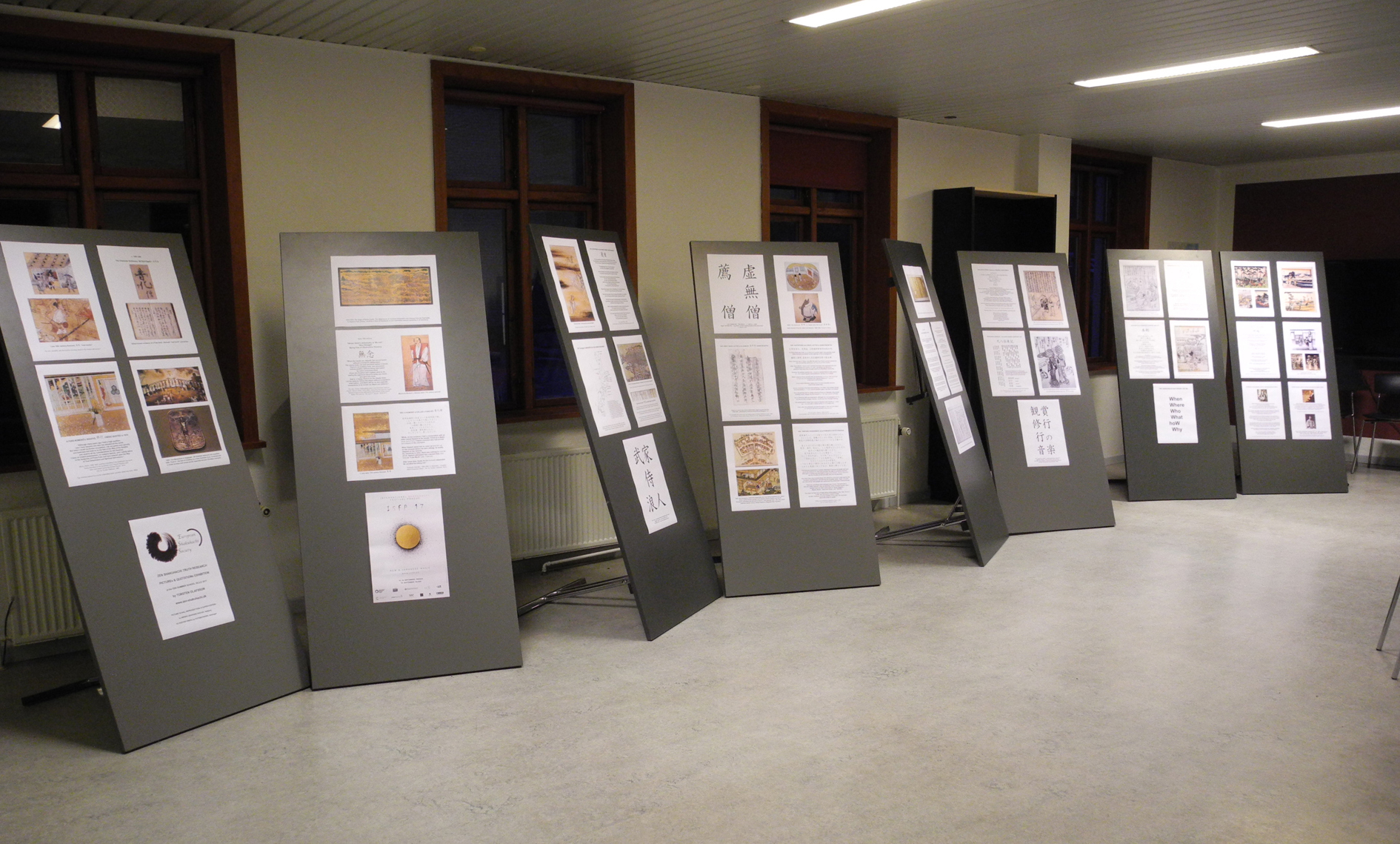
A section of musician, shakuhachi player & historian Torsten Olafsson's "Pictures & Quotations Exhibition"

Maekawa Kōgetsu Sensei testing the acoustics in Our Saviour's Church in Vejle, Saturday, July 29th

Kiku Day introducing the teachers' concert in Our Saviour's Church in Vejle, Saturday, July 29th
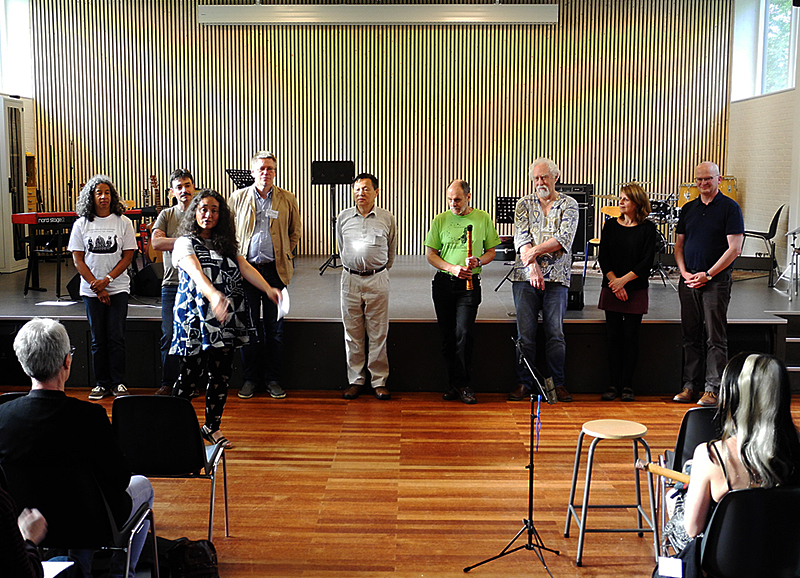
Kiku Day and all the shakuhachi teachers after the amazing and joyful students' shakuhachi,
koto and song concert on Sunday, July 30th, 2017. Left to right:
Hélène Seiyū Codjo, Suizan J.F. Lagrost, Kiku Day, Gunnar Jinmei Linder, Maekawa Kōgetsu,
Dr. Jim Franklin, David Hughes, Emmanuelle Rouaud and Wolfgang Fuyūgen Heßler
February 9, 2019:
Torsten Olafsson, Denmark, presents his very last "Ascetic Shakuhachi" concert lecture
at the Culture Yard (Kulturværftet) in Elsinore/Helsingør, N. Sealand:
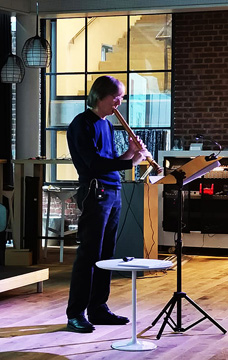
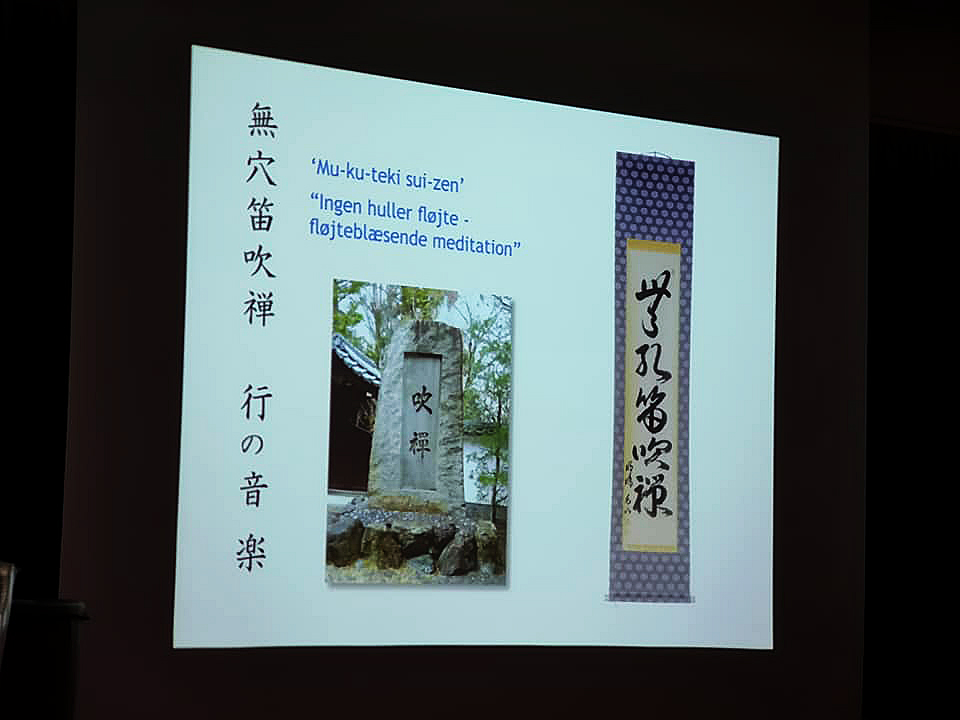

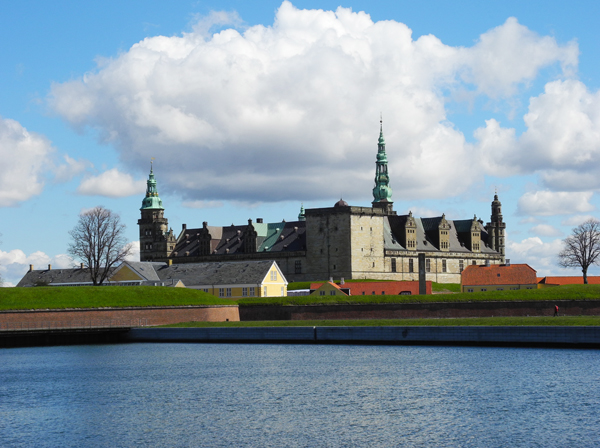
EPILOGUE
"They have rites and ceremonies so different from those of all other nations that it seems that they deliberately try to be unlike any other people.
The things they do in this respect are beyond imagining and it may truly be said that Japan is a world the reverse of Europe."
By the Italian Jesuit missionary Alessandro Valignano, S.J. in a report of his, 1584
In: Cooper, 1965, the page preceding the Preface.
"A sound is a sound. To realize this: One has to put a stop at studying music."
John Cage (1912-1992) in his important book "Silence. Lectures and writings."
Wesleyan University Press, Middletown, 1961, p. 185.
Postscript:
"The deep questions we write out
are but marks in a dream.
When we wake up,
even the questioner is gone."
Ikkyū Sōjun, Daitoku-ji, 1457.
Trsl. by James E. Sanford, 1981.
|
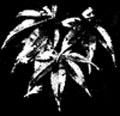
Momiji
|
